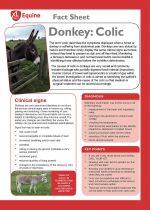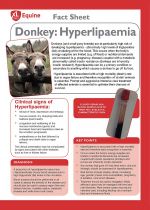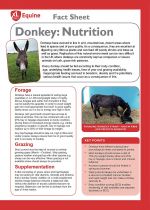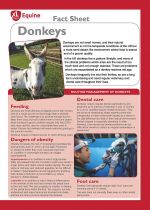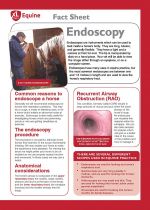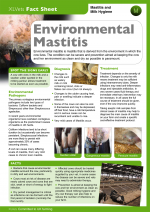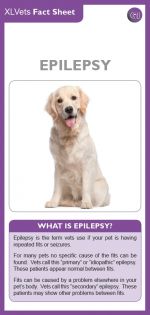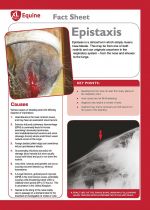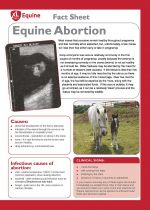Factsheets -
Below are Word and PDF files of our Factsheets. You will need Adobe Reader to view the PDF files - if you need to download Adobe Reader please click here.
Please note: some of these factsheets are several pages long and are large files, so please be patient when downloading!
Donkey: Colic
The term ‘colic’ describes the symptoms displayed when a horse or donkey is suffering from abdominal pain. Donkeys are very stoical by nature and therefore rarely display the same clinical signs as horses; instead they tend to present as dull and off their feed. Monitoring a donkey’s demeanour and normal bowel habits can be helpful in identifying those affected before the condition deteriorates.
The causes of colic in donkeys are very varied and commonly include blockage with partially digested food material (impaction), muscle cramps of bowel wall (spasmodic) or a build of gas within the bowel. Investigation of colic is aimed at identifying the patient’s physical status and the cause of the colic so that medical or surgical treatment can be tailored accordingly.
Donkey: Hyperlipaemia
Donkeys (and small pony breeds) are at particularly high risk of developing hyperlipaemia - abnormally high levels of triglycerides (fat) circulating within the blood. This occurs when the body’s energy supplies are limited (e.g. off feed) or nutritional demands are increased (e.g. pregnancy, disease) coupled with a metabolic abnormality called insulin resistance (donkeys are inherently insulin resistant). Hyperlipaemia can be a primary condition or secondary to anything which causes a donkey to go off its food.
Hyperlipaemia is associated with a high mortality (death) rate due to organ failure and therefore recognition of ‘at risk’ animals is essential. Prompt and aggressive intensive care treatment of affected animals is essential to optimise their chances of survival.
Donkey: Nutrition
Donkeys have evolved to live in arid, mountainous, desert areas where feed is sparse and of poor quality. As a consequence, they are excellent at digesting very fibrous plants and can feed off woody shrubs and trees as well as grass. Replication of this natural environment can be very difficult in the UK where donkeys are commonly kept as companion or leisure animals on lush, grass-rich pastures.
Every donkey should be fed according to their body condition, age, underlying health issues, time of year and grazing availability. Inappropriate feeding can lead to boredom, obesity and the potentially serious health issues that occur as a consequence of this.
Donkeys
Donkeys are not small horses, and their natural environment is not the temperate conditions of the UK but a more semi-desert like environment where food is scarce and of a poorer quality.
In the UK donkeys live a pasture lifestyle, and many of the clinical problems which arise are the result of too much food and not enough exercise. These are problems which are exacerbated as a donkey reaches old age.
Donkeys frequently live into their thirties, so are a long term undertaking and need regular veterinary and dental care throughout their lives.
Dry Eye (Keratoconjunctivitis Sicca)
Keratoconjunctivitis sicca (KCS) is a relatively
common problem seen in dogs, often termed ‘dry
eye’. Dry eye occurs due to a reduction in the quality
of tear production in your dog’s eye. Tears normally
keep your pet’s eye healthy and lubricated. If your
pet is not producing enough tears they can quickly
develop sore, infected eyes and in severe cases
vision can be affected.
Endoscopy
Endoscopes are instruments which can be used to look inside a horse’s body. They are long, tubular, and generally flexible. They have a light and a camera at their far end. The tip is manipulated by dials on a hand piece. Your vet will be able to view the image either through an eyepiece, or on a computer screen.
Endoscopes have many uses in equine practice, but the most common endoscopes are between one and 1.5 metres in length and are used to view the horse’s respiratory tract.
Epilepsy
Epilepsy is the term vets use if your pet is having
repeated fits or seizures.
For many pets no specific cause of the fits can be
found. Vets call this “primary” or “idiopathic” epilepsy.
These patients appear normal between fits.
Fits can be caused by a problem elsewhere in your
pet’s body. Vets call this “secondary” epilepsy. These
patients may show other problems between fits.
Epistaxis
Epistaxis is a clinical term which simply means nose bleeds. This may be from one or both nostrils and can originate anywhere in the respiratory system – from the nose and sinuses to the lungs.
Equine Abortions
Most mares that conceive remain healthy throughout pregnancy and foal normally when expected, but, unfortunately, a few mares will lose their foal either early or late in pregnancy. Early embryonic loss occurs relatively commonly in the first couple of months of pregnancy, usually because the embryo is not developing correctly or the uterus (womb) is not as healthy as it should be. Older foetuses may be aborted by the mare for a number of reasons (see causes). If the foetus is less than five months of age, it may be fully resorbed by the uterus so there is no external evidence of this miscarriage. Over five months of age, the foal will be expelled by the mare, along with the placenta and associated fluids. If this occurs outside, it may go unnoticed, as it can be a relatively ‘clean’ process and the foetus may be removed by wildlife.
